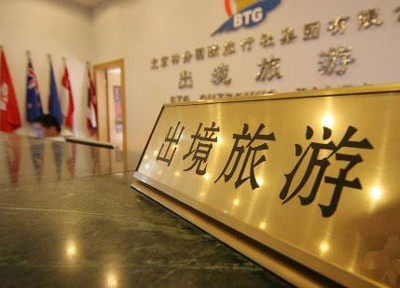(单词翻译:单击)
Investors in search of an emerging consumer story need look no further than the remarkable growth in the scale and spending of Chinese outbound tourists.
寻找新兴市场消费者故事的投资者无需费力,他们只要看看中国出境游客人数和消费的迅猛增长就够了。
China Confidential, a Financial Times research service, estimates that total spending by Chinese travellers on outbound trips hit Rmb3.1tn ($498bn) in 2014. Spending by Chinese tourists is now greater than total spending on household consumption of around $436bn in Indonesia and $442bn in Turkey. And this figure is even more remarkable given that the Chinese outbound tourism trend is at a relatively early stage. Although the number of Chinese outbound trips grew 20 per cent year-on-year to 117m in 2014, according to official tourism statistics, less than 6 per cent of the population hold a passport.
据英国《金融时报》旗下研究机构《中国投资参考》(China Confidential)估算,2014年中国游客在出境游期间的总支出达到3.1万亿元人民币(合4980亿美元)。也就是说,如今中国出境游客的支出大于某些国家的家庭消费总支出,比如印尼(4360亿美元)和土耳其(4420亿美元)。令这个数字更加可圈可点的是,中国出境旅游发展趋势仍处在一个相对早期的阶段。虽然中国出境游人数在2014年同比增长了20%,达到1.17亿人次,但根据官方旅游统计,目前只有不到6%的中国公民持有护照。

China Confidential’s estimate for total spending is higher than the official estimate of $200bn, which excludes spending on flights, visas and other items. But the figures are in line with those from other external sources. They closely match estimates of non-educational spending by Chinese visitors to the US, for example, by the US National Tourism Office.
《中国投资参考》估算的总支出高于2000亿美元的官方估算,后者不包括航班、签证和其他一些项目上的支出。但这些数字与其他外部来源的数字基本相符。比如,在中国赴美游客非教育支出这一项上,它们就与美国国家旅游局(National Tourism Office)估算的数字非常接近。
However, while the amount of current spending and the potential for growth remain enormous, there are signs that many travellers are starting to cut back on spending while overseas as their priorities change.
然而,尽管当前消费总额和增长潜力仍非常巨大,但有迹象表明,随着个人优先事项的改变,许多中国旅客开始在境外旅游期间削减开支。
In particular, China Confidential’s latest annual report on outbound tourism, released this week and based on a survey of 1,288 outbound tourists and 40 travel agencies nationwide, identified a 6.2 per cent year-on-year slowdown in per capita spending on travellers’ outbound trips during 2015, following a 9.4 per cent decline between 2013 and 2014. The most recent contraction was led by an 8 per cent year-on-year decline in spending on shopping.
本周发布的最新《中国投资参考》出境旅游年度报告基于对全中国1288名出境游客和40家旅行社进行的一项调查。报告发现,2015年出境游客人均支出同比下降了6.2%,而2013年至2014年人均支出已经下降了9.4%。最新的收缩主要是由购物支出同比下降8%导致的。
This slowdown was particularly marked among high-income travellers. Those with annual household incomes in excess of Rmb350,000 said they spent an average of Rmb16,440 on shopping on their most recent trip, down 34.4 per cent from the previous year, although still accounting for a sizeable 34.3 per cent of their total spending, compared with 44.2 per cent in China Confidential’s survey last year.
这种放缓在高收入游客中尤其明显。家庭年收入超过35万元人民币的人士表示,他们最近一次旅游期间在购物上平均花费了16440元人民币,比上年下滑34.4%,尽管购物支出仍占他们总支出的相当大一部分(34.3%)。相比之下,《中国投资参考》去年调查发现的购物支出占比为44.2%。
The lower spend on shopping is in part related to domestic conditions. The general macroeconomic slowdown may have prompted some travellers to rein in their spending during overseas trips, while Beijing’s anti-corruption drive has resulted in a marked reduction in gifting purchases among wealthier travellers in particular.
减少购物支出在一定程度上与中国国内形势有关。宏观经济整体放缓可能促使一些游客在境外游期间收敛开销,而北京方面的反腐败斗争已明显抑制了礼品购买,尤其是对比较富裕的游客而言。
However, it would be wrong to view this slowdown purely in macro or policy terms. Instead, lower spending on shopping is part of a broader shift in spending priorities, with wealthier travellers increasingly prioritising experiences over luxury purchases. On average, travellers in the high-income cohort spent 31.1 per cent more than they had a year earlier on entertainment and 78.6 per cent more on other services including car rental and excursions. Those making purchases are increasingly opting for more affordable or lesser known brands, echoing trends seen domestically.
然而,单纯从宏观或政策角度来解释这一放缓是不对的。实际上,减少购物支出是支出优先顺序全面转变的一部分,比如较富裕的游客日益把“体验”置于购买奢侈品之上。平均而言,高收入阶层游客的娱乐支出同比增长31.1%,在其他服务(包括汽车租赁和当地短途游)上的支出同比增长78.6%。购物的游客也日趋选择更实惠或不太知名的品牌,与中国国内出现的趋势不谋而合。
These shifting priorities should broaden the potential beneficiaries of the Chinese outbound trend beyond the luxury retailers that have been the chief winners to date. Rising spending on experiences should benefit hospitality, entertainment and tourism service industries to a far greater extent than in the past, when many Chinese overseas travellers scrimped on hotels, food and activities to spend more at the shops. And the beneficiaries will not just be the big-name hoteliers, restaurateurs and tourist attractions, with many travellers seeking to ditch the growing crowds of fellow countrymen and venture off the beaten track.
支出优先顺序的这种转变,应当会拓宽中国出境游趋势的潜在受益者群体,使其不仅限于迄今的主要赢家——奢侈品零售商。在体验上的支出不断增长,应当会让酒店、娱乐和旅游服务行业的受益程度大大超过以往(以往中国出境游客往往在酒店、餐饮和活动上精打细算,以便省下钱来在商店购物)。而且受益者将不仅限于大牌的酒店、餐厅和旅游景点,因为很多出境游客想避开越来越多同样来自中国的旅游团,到热门旅游路线以外的地方去看一看。
China’s outbound journey has plenty of mileage left to run. Understanding rapidly shifting tastes and spending patterns will be key to capitalising on this long-term growth story.
中国出境旅游还有极大发展空间。理解快速变化的品味和消费模式,将是利用这一长期增长故事获利的关键。


